Key takeaways:
- Identifying potential partners involves aligning goals and values, utilizing networking events, and leveraging online platforms for connections.
- Effective partnership research includes surveys, content exploration, and open discussions to understand mutual objectives and priorities.
- Establishing mutual goals and maintaining open communication through regular check-ins fosters collaboration and ensures alignment.
- Long-term relationship success relies on consistent actions, celebrating milestones, and evaluating both quantitative metrics and emotional connections.
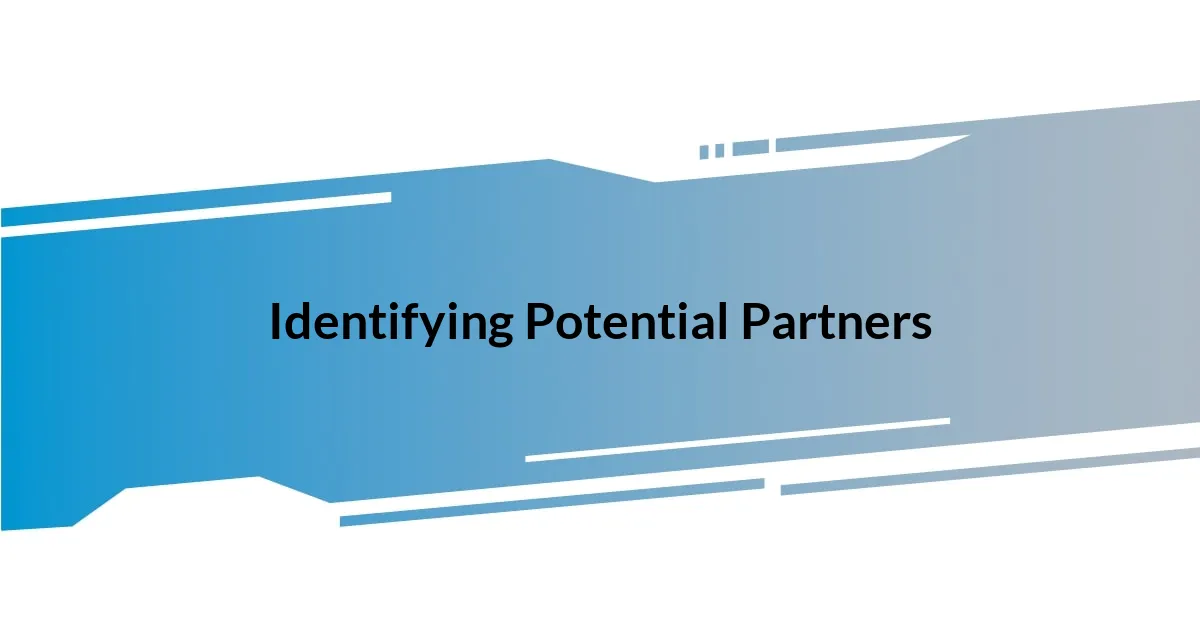
Identifying Potential Partners
When I set out to identify potential partners, I started by reflecting on my own goals and values. What do I truly want to achieve? This clarity helped me pinpoint organizations that share similar visions. It’s like looking for a dance partner—if you can’t sync your steps, it’s going to be a struggle.
I also found networking events essential for discovering promising partners. I vividly remember a local conference where, over casual coffee chats, I unearthed connections I hadn’t expected. It struck me how organic these relationships can form when people are genuinely interested in each other’s work. Have you ever had a conversation that made you rethink a partnership? Those moments are gold.
Lastly, leveraging online platforms became a game changer for me. I utilized social media and professional networks to explore organizations that resonated with my mission. I would often ask myself: Who is making waves in my field? Connecting with those individuals not only expanded my reach but also enriched my perspective in ways I hadn’t anticipated.
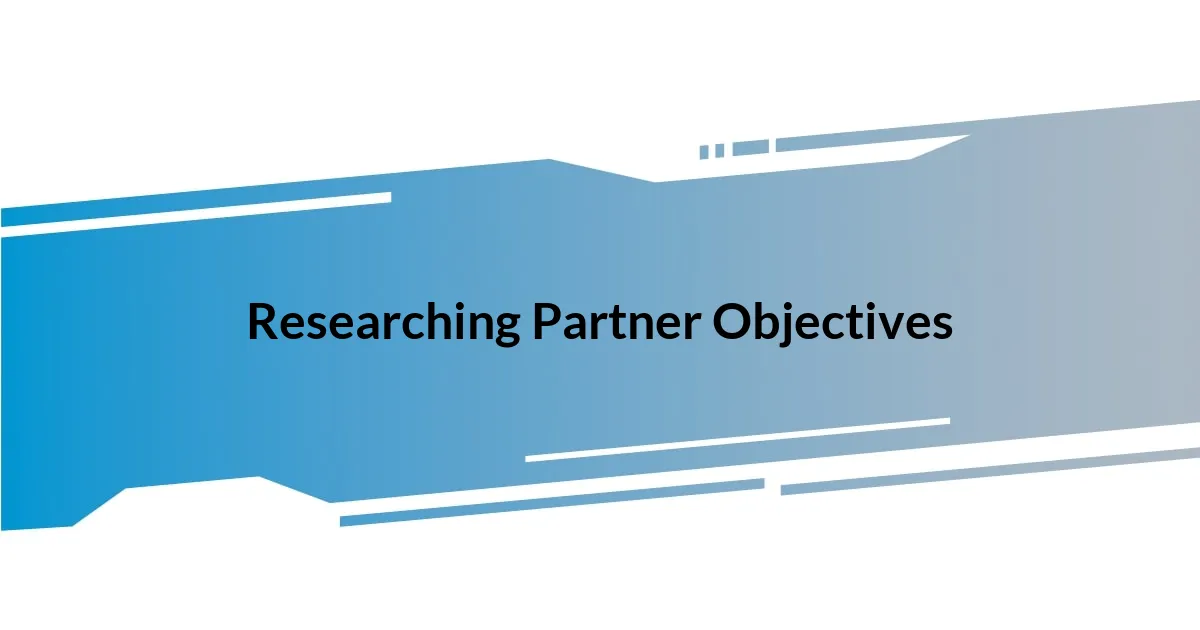
Researching Partner Objectives
Understanding your potential partner’s objectives is crucial for a successful collaboration. When I began to dig deeper into what my potential partners really wanted to achieve, it was like pulling back the curtain on their motivations. I recall a meeting with a potential partner where they shared their aspirations for increasing brand visibility. That conversation illuminated how our goals could align beautifully, transforming what could have been a simple partnership into a strategic alliance.
Here’s a shortlist of ways to effectively research partner objectives:
- Conduct Surveys: I found that directly asking potential partners through surveys can provide valuable insights into their goals.
- Explore Their Content: Reviewing their blog posts or social media can reveal what they prioritize.
- One-on-One Discussions: Engaging in open conversations helps uncover unspoken objectives and mutual interests.
- Market Research: Understanding their market challenges allows for targeted strategies that benefit both parties.
- Follow Industry Trends: Keeping up with trends in their sector helps anticipate their evolving goals.
Each of these strategies has shaped my understanding of what a partnership can truly entail, ensuring that both sides stand to gain something meaningful.
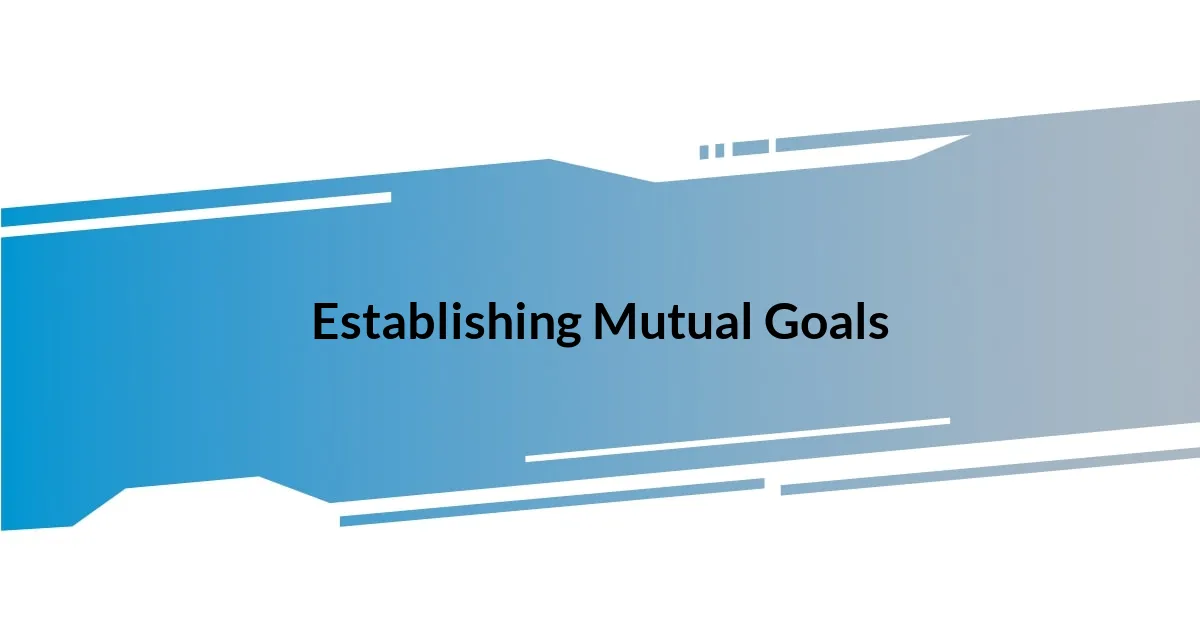
Establishing Mutual Goals
Establishing mutual goals is where the magic of collaboration starts. I learned that defining shared aspirations can transform a partnership from a mere exchange into a powerful synergy. For example, I once worked with a nonprofit that aimed to expand its outreach. By openly discussing our individual goals, we discovered a common desire to harness our resources for greater community impact. It felt amazing to see our ambitions align so seamlessly, as if both of us had suddenly opened a window to new possibilities.
As I navigated this process, I found it beneficial to create a collaborative vision statement. During one brainstorming session, we crafted a statement that encapsulated our dreams and intentions. The energy in that room was palpable—everyone was excited about what we could achieve together. Have you ever experienced that kind of collective enthusiasm? It’s a rare and powerful moment that reinforces commitment to those shared goals. Knowing we were on the same path invigorated our efforts, guiding each decision with a clear focus.
Finally, I can’t stress enough the importance of regular check-ins to ensure we maintain that alignment. I remember setting up bi-weekly meetings with partners to review our goals and progress. In one particular meeting, we recalibrated our objectives based on market changes. This flexibility was not only necessary but also affirmed our partnership’s resilience. It’s incredible how revisiting mutual goals keeps the connection strong and vibrant.
| Goal Setting Approach | Benefits |
|---|---|
| Collaborative Vision Statement | Creates shared enthusiasm and focus |
| Regular Check-Ins | Ensures alignment and adapts to changes |
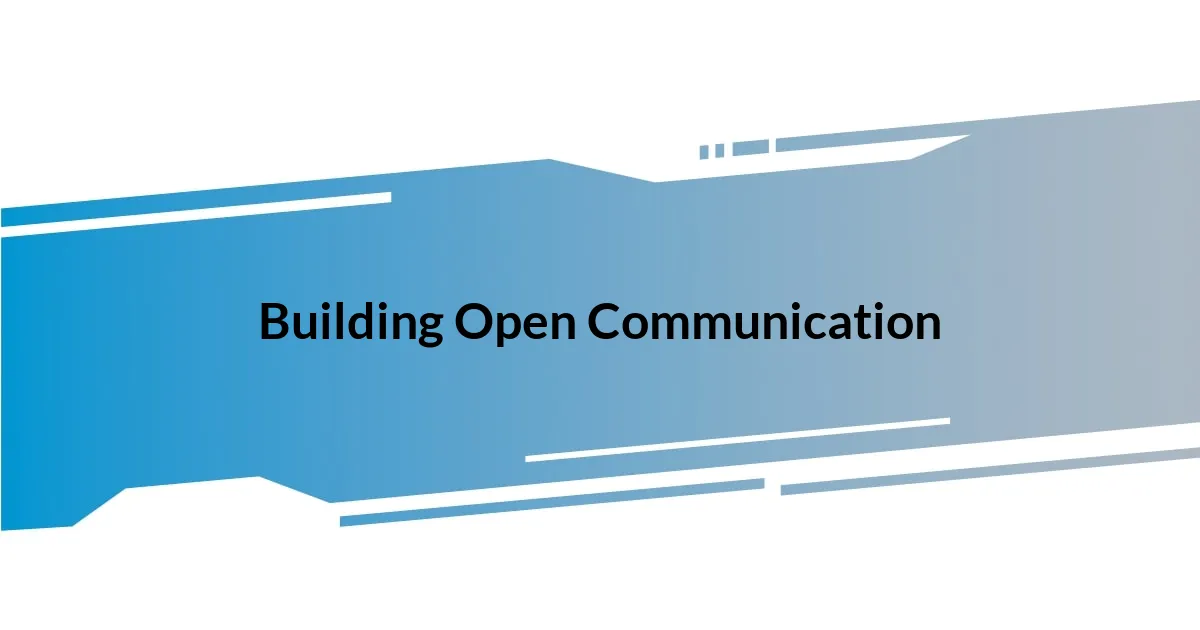
Building Open Communication
Building open communication has been a cornerstone of my partnership experiences. I remember a time when I collaborated with a tech startup, and we were both excited yet apprehensive about sharing our ideas. I initiated an informal chat over coffee, which turned out to be the best decision. It felt as though the barriers melted away, revealing our true aspirations and concerns. Isn’t it striking how a simple conversation can lay the groundwork for trust?
Another vital aspect of open communication is consistency. I made it a practice to send weekly updates to my partners, not just about our ongoing projects but also about industry news and trends. I often share an insight or an interesting article I came across. This small gesture has fostered a sense of connectedness and mutual respect. Have you ever found that sharing knowledge expands the bond in a collaboration? It’s fascinating how staying informed and engaged leads to deeper conversations.
Active listening also plays a significant role in fostering openness. One instance that stands out for me was during a brainstorming session where one of my partners had a unique idea for a campaign. I made a conscious effort to listen intently and ask clarifying questions. Acknowledging their thoughts not only validated their input but also sparked further creativity. It made me realize that when people feel heard, they’re more likely to contribute freely. Wouldn’t we all appreciate a partnership where our voices truly matter?
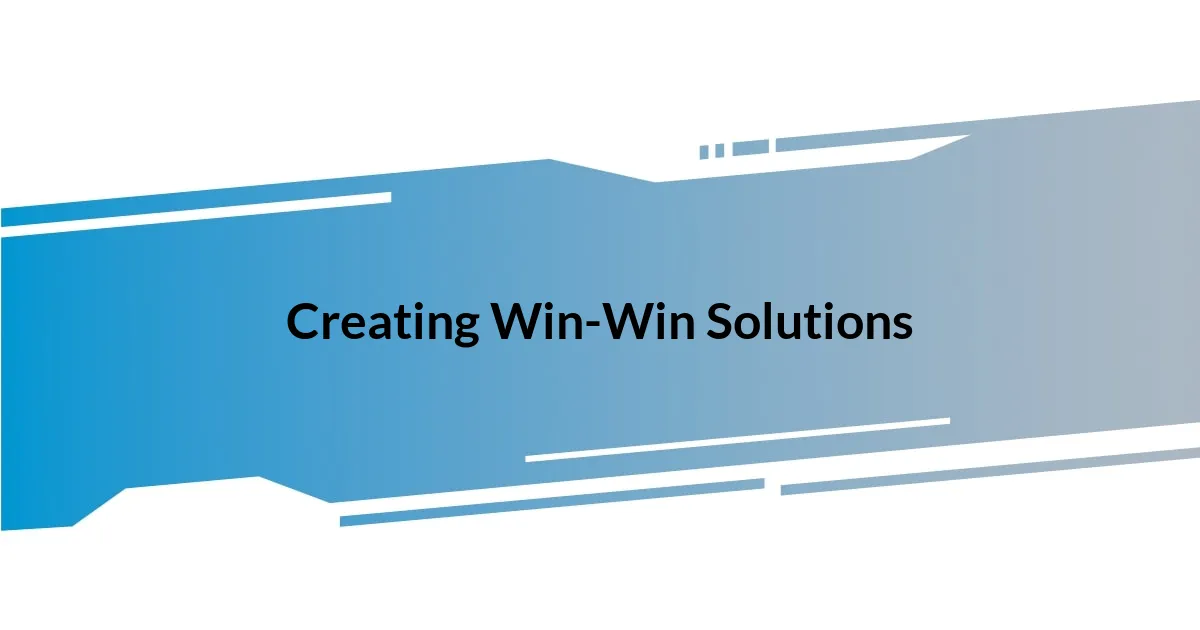
Creating Win-Win Solutions
Creating win-win solutions is an art that requires a deep understanding of each partner’s needs. In one collaboration, I partnered with a small food co-op and a local farm. After several discussions, we realized that by combining their organic produce with our community events, we could not only boost sales but also promote sustainable practices. Seeing both sides benefit from the arrangement was exhilarating; it felt like we were crafting a miniature ecosystem of support.
In my experience, tapping into creativity often leads to unexpected solutions. I recall a project where both my team and a marketing agency struggled to agree on the promotional strategy. Instead of pushing our own agendas, we decided to host a workshop where everyone could propose ideas. It was thrilling to watch innovative concepts emerge from that environment. Have you ever witnessed how shared brainstorming can turn competition into collaboration? That experience reinforced the notion that together we could create something far greater than just our individual visions.
Lastly, patience and flexibility are paramount. I vividly remember a situation where we had to shift our approach mid-project due to unexpected challenges. Instead of seeing this as a setback, we leaned into the situation, adapting our strategies and redefining success. That moment taught me that a true partnership flourishes when both parties are willing to navigate changes together. It’s fascinating how embracing uncertainty can lead to unforeseen opportunities for growth.
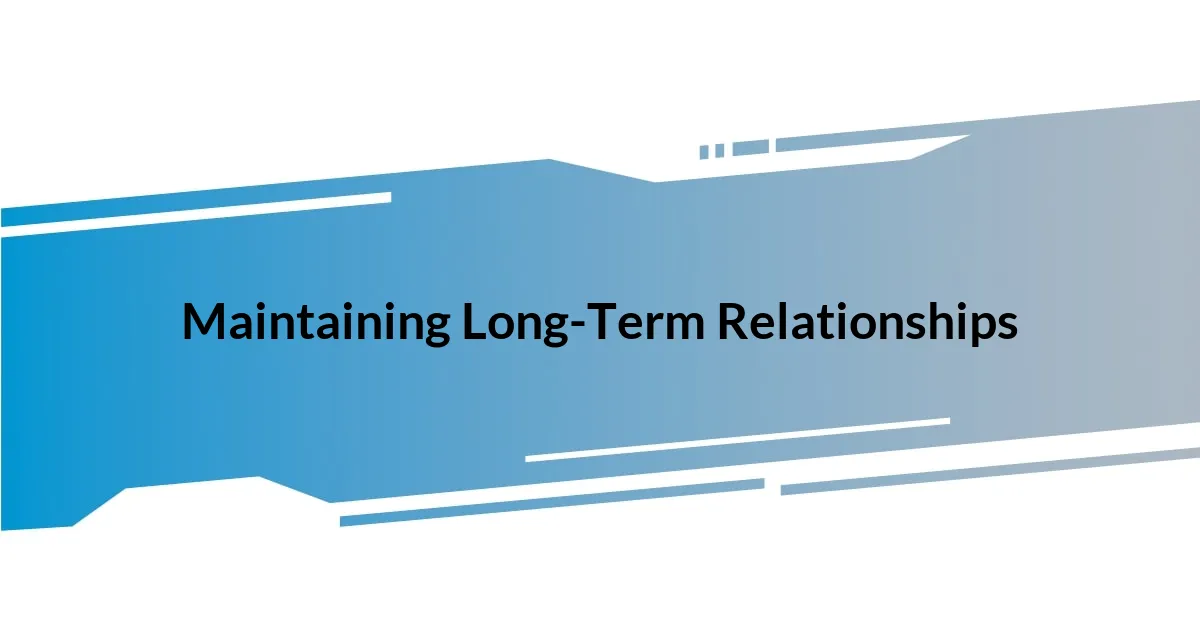
Maintaining Long-Term Relationships
Maintaining long-term relationships is about honoring the commitment you’ve made to each other. I recall a networking dinner where I made a genuine connection with another entrepreneur. Years later, we collaborated on a project, and I was reminded of how that initial investment in our relationship paid off. Isn’t it rewarding to see how those early conversations evolve into significant partnerships?
Trust doesn’t develop overnight; it’s built through small, consistent actions. For instance, I always make it a point to follow through on promises, whether it’s delivering feedback or simply checking in. One time, I forgot to send a timely update to a partner. They brought it up later, and I realized how deeply it affected their perception of our reliability. Have you ever noticed how even the smallest lapse can create doubt? It reinforced my belief that diligence in communication fosters a solid foundation.
Celebrate milestones together, too—it’s a fantastic way to strengthen the bond. I once organized a small gathering to acknowledge a partner’s achievement in our joint venture. Watching their joy as we raised a toast was energizing and reminded me that shared victories nurture loyalty. Don’t you think celebrating together brings partners closer? Those moments of joy build a deeper connection that not only sustains the partnership but also enriches our collaborative journey.
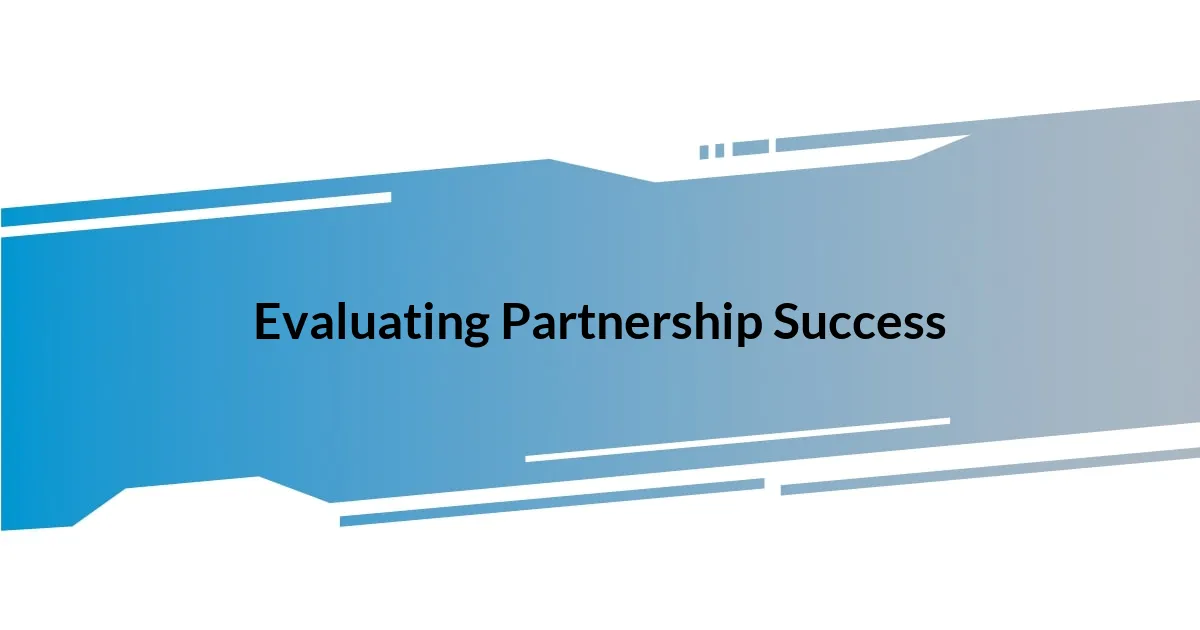
Evaluating Partnership Success
Evaluating the success of a partnership involves a careful balance of metrics and intuition. I remember when I worked with a tech startup; we set specific performance indicators such as customer engagement and sales growth to measure our impact. Yet, the most telling success moments weren’t just in the numbers; they were in the enthusiastic feedback we received from customers who loved our joint offerings. Isn’t it fascinating how data alone can’t capture the whole story?
In my experience, regular check-ins serve as an invaluable tool for gauging partnership health. For example, I initiated monthly catch-up calls with a nonprofit we teamed up with, where we discussed not only progress but also any emerging concerns. The conversations often led to adjustments that kept our collaboration alive and thriving. Have you found that sharing experiences openly can illuminate paths to improvement?
Lastly, the emotional connection between partners can be a crucial indicator of success. I recall a particularly challenging phase with a partner when we faced setbacks. Instead of focusing solely on troubleshooting, we took time to share our frustrations and triumphs, reinforcing our bond. That vulnerability turned into a strength, reminding me that the human element can profoundly influence partnership success. How do you foster that emotional connection in your collaborations?